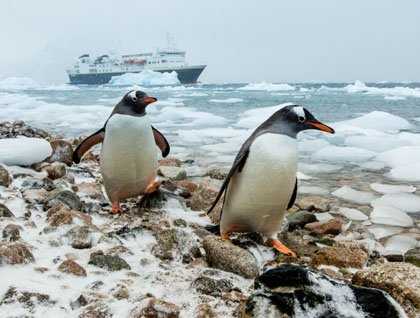It was an atmospheric morning. Mist, low clouds, wind and snow. Photographers seeking neutral, or 18% grey, were rewarded with every shade of grey an artist could muster and then some. But it was hardly neutral: it started mildly and veered towards the hostile. We needed to board Zodiacs to get ashore at Neko Harbour, and the tone was set immediately by an obstreperous iceberg which parked itself right outside the port tender entrance, blocking all egress. Loading on the starboard side, our storm troopers flinched as the keen wind peppered them with snow pellets, and soon found themselves stumbling into shallows choked with great blocks of glacial ice. Then up a set of hand-cut frozen steps and onto deep snow.
This is the real Antarctica: harsh, cold and unforgiving. Time to rely on our own survival skills: determination, balance and a critical choice of clothes: base layers, warm shirts, fleeces, brinylon outer coats, gloves, balaclavas, snow goggles and woolly hats. How humiliating then to be met on the same path by the locals: Gentoo penguins wearing nothing but a single suit of feathers and neither socks, goggles nor boots. How do they do it? It took them over 40 million years of trial and triumph to become utterly at home here—we should remind ourselves that we are the newcomers on this planet (and we looked it, slip-sliding around on the snow).
Hardy souls trudged up to a higher vantage point on the hillside, others still on board scanned for the humpback whales we had seen on our way in. The rest of us loitered, fascinated by the main Gentoo colony that waits stoically for the deep snow to clear. It has fallen heavily in the last week: several were buried up to their necks in tight-packed snow, reluctant to abandon early eggs; the rest cannot lay theirs until the snow melts to reveal last year’s nests. This is not the weather they need: it should be dry and cold now, not wet and windy. A warmer ocean whips up stronger winds and dumps more snow, the last thing these nesting birds need right now.
In the afternoon everything changed again: photographers were taken aback by bright sunshine and had to retreat, bewildered by dazzling white mountains and bright scintillating waves. Too much light suddenly after not enough!
Many gathered in confused crèches in the chart room, complaining of unruly histograms, trying to console themselves with hot chocolate. This place can change with lethal suddenness as we saw this morning when our calm beach landing site was turned into raging surf by the waves from a spectacular calving event at the glacier opposite. (Precautions were taken and everyone was safe.) By midday we set course for Dallmann Bay and the open ocean. Now we are taking on the biggest challenge of all, the Drake Passage—this notorious stretch of ocean guards the approach to the White Continent and is sometimes known as the Whiteknuckle Wavemaker. We trust in our sturdy ship and the expertise of its veteran officers and crew.









